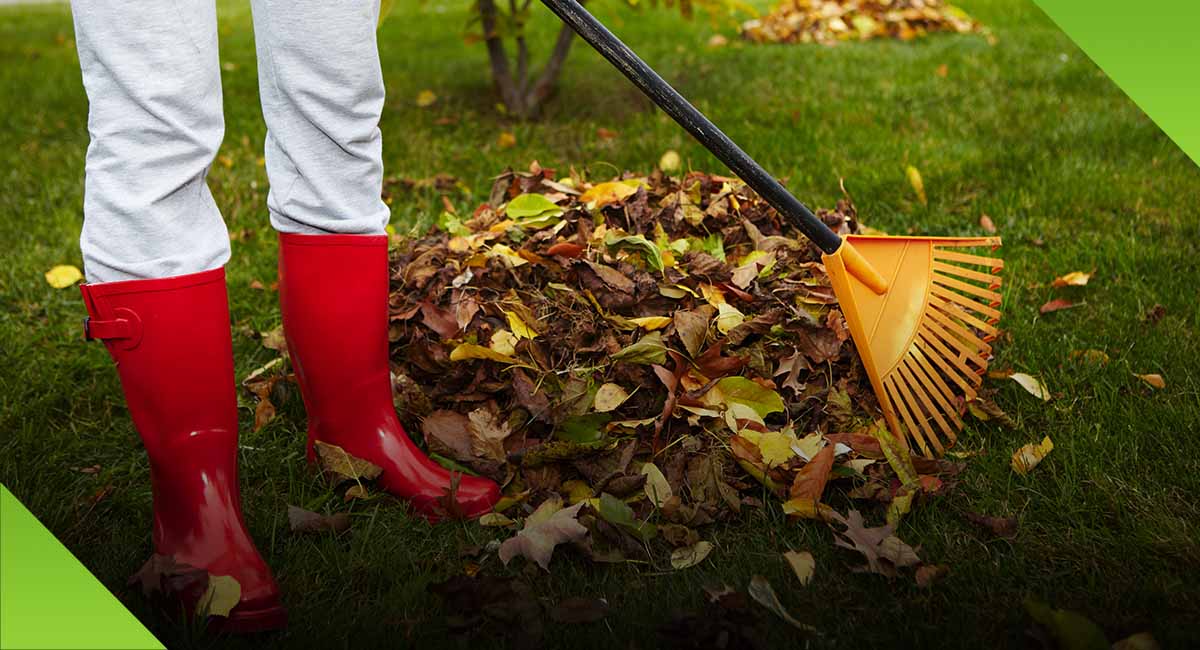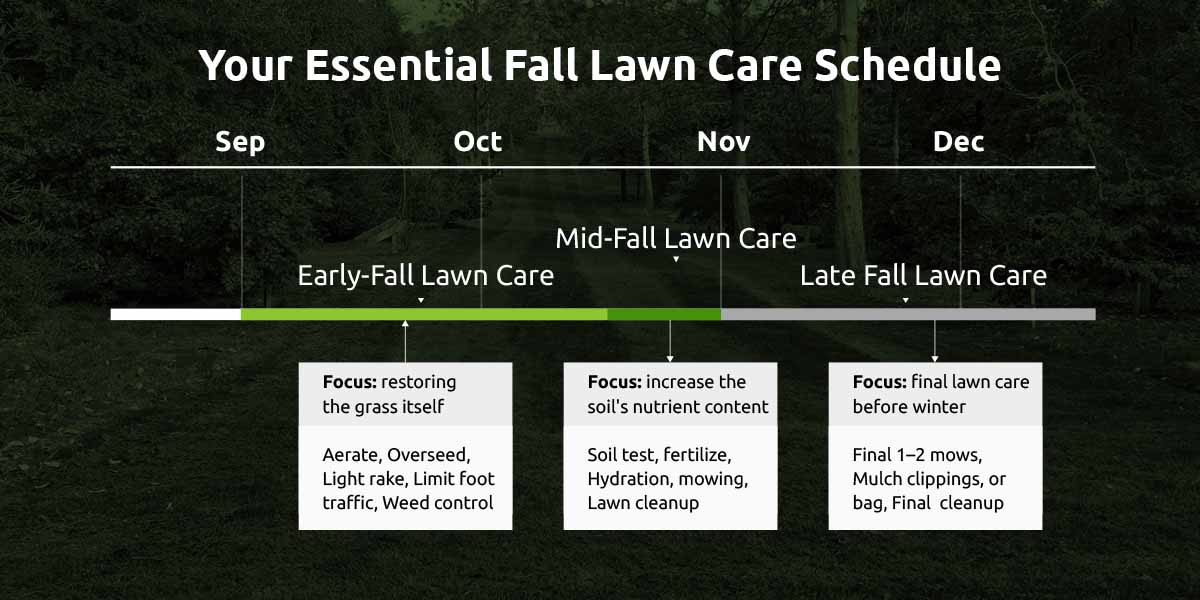
As the heat dials down after the summer, so does plant growth. But that doesn’t mean you need to give up on the hope of a lush lawn with vibrant greens. Several tips and tricks can help you properly prepare your yard for winter. Here, we explore what to do to care for your lawn in the fall so it looks its best when spring comes.
Why Fall Lawn Care Is Crucial for Commercial Properties
From office buildings to warehouses, preparing your property for fall is essential to maintaining the professional aesthetic your company is known for. Proper lawn care is a welcoming sign for clients and tenants, while a neglected lawn can negatively affect your property’s appeal and detract from your business’s reputation.
During the summer months, the lawn on your commercial property endures a lot — high temperatures, direct sunlight, periodic droughts, and severe storms. Couple these conditions with high foot traffic, and you understand why your lawn needs restorative care in the fall.
Fall is the primary recovery season for your grass, allowing it to build resilience and repair damage. With the harsh winter of the Midwest, your grass also uses fall to prepare for the cold weather Minnesota is known for.
Investing in fall lawn treatment gives your grass a fighting chance, ensuring it can survive the winter and green up faster in the spring.
Your Essential Fall Lawn Care Schedule
The chronological guide below is designed to give you an easy-to-follow schedule for protecting your lawn. This guide is not a conclusive directive for every property. Customize every step according to your grass and weather patterns.
Debris removal is integral to the fall yard clean up, from September to December. Remember to remove leaves, sticks and other debris from your yard before you start any type of lawn treatment.
Early Fall Lawn Care
In the early stages of fall, lawn care should focus on restoring the grass itself. You want to ensure the grass is fuller and maximize the nutrients already available in the soil. Slot in soil aeration from September through early October. Aeration enhances root growth by allowing oxygen, moisture, and nutrients to penetrate the soil. It is particularly important if you have compacted soil that can restrict nutrients from reaching the roots.
If you are unsure if your soil is compacted, run a quick screwdriver test. Try pushing the screwdriver through the soil. If you struggle to get it through easily, chances are high that you have compacted soil. You can use several tools to aerate the soil, including a spike aerator and a garden fork, but our favorite is a core aerator. A core aerator pulls plugs around 3 inches long from the soil, opening it up for oxygen and nutrients.
After aeration, it is time for overseeding to thicken the turf. Overseeding will fill the bare patches caused by grass thinning over the summer. Ensure that you pick a high-quality grass seed that matches your existing grass. With Minnesota’s continental climate, opt for a cool-season grass that can survive hot temperatures. Tall fescue grass is an excellent option due to its resistant characteristics, which allow it to adapt to most environmental conditions.
If your property has several shaded spots, remember to purchase a premium sun and shade mix. Gently rake the lawn after overseeding and control foot traffic to give the new seeds a chance to germinate.
The final item on your fall lawn care schedule is weed control. Weed control in the fall offers superior results since weeds redirect the nutrients they receive to their roots to prepare for winter. This energy-conserving process means any herbicide you apply will be redirected from the leaves to the roots, resulting in a more permanent solution.
Mid-Fall Lawn Care
As we get deeper into October, the next phase is to increase the soil’s nutrient content. You will need a rich fall lawn treatment fertilizer with a formulation prioritizing potassium over nitrogen. Since we are headed into winter, you want to promote and reinforce root development over top leaves, so you need less nitrogen and more phosphorus and potassium. You can also use a soil tester to determine your soil’s specific needs.
Follow the fertilizer with a good amount of water. Even as temperatures lower, your newly seeded grass will need adequate hydration to encourage growth. Watering also ensures that the fertilizer penetrates the soil. However, be careful how much water you put on your grass, so as not to drown your new seeds. Create a custom watering schedule, considering weather conditions like wind, rain, and the amount of sunlight your grass gets.
Lawn clean up should also be a part of your October checklist. You want to wait as long as possible before mowing your lawn to allow the new grass to grow. But remember to keep checking the growth rate to ensure that the preexisting grass doesn’t tower over the new one, as it can block it from receiving sunlight.
Allowing thick leaves to layer on your grass will not only block sunlight but also stunt its growth. Moisture from the leaves can also be the perfect breeding ground for fungal diseases like snow mold.
Late Fall Lawn Care
These are the final steps to care for your lawn before winter hits. This schedule will run from November to early December. At this time, you will conduct your final mowing. Cut the grass one to two more times, depending on growth.
Overgrown grass will mat under the snow, leading to molding and dead patches in the spring. But don’t cut the grass too low, as this can expose the crown to the cold.
Complete another round of clean-ups, ensuring no debris on the grass. If you can, mulch the grass with a mower to allow nutrients to return to the soil. But if you are worried about layering and mold, collect the cut grass. Gently rake away any other debris, like tree leaves and twigs, that could smother the grass.
Simplify Your Fall Yard Preparation With Green and Black
Preparing your yard for fall ensures your property maintains its curb appeal and your lawn is ready for a comeback in spring. However, properly maintaining a lawn requires expertise, specialized tools, and time. At Green and Black, we offer lawn care solutions for businesses and rental properties. Our specialists can handle everything from aeration to pre-winter mowing.
Backed by over 15 years of experience and equipped with the latest tools, you can trust us to help you maintain your image while caring for your grass. There is no need to wonder how to prepare your lawn for fall — we will do it for you.
Contact us to learn more about our services or request a free quote today.



